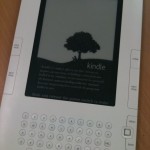 Libraries are definitely on the brink of a paradigm shift in terms of lending. In an effort to give a variety of e-book options a try for my students, we invested in four Kindles a few months ago. Teachers had the first opportunities to check them out, but we began with student check-outs two weeks ago.
Libraries are definitely on the brink of a paradigm shift in terms of lending. In an effort to give a variety of e-book options a try for my students, we invested in four Kindles a few months ago. Teachers had the first opportunities to check them out, but we began with student check-outs two weeks ago.
We had already invested in a variety of other e-book options for students, like e-books embedded in our catalog from Follett and Gale, but so far, the Kindle has gotten the most response from students for fiction reading. In fact, I only advertised the availability of the Kindles on our library website, but didn’t offer much other fanfare, and students have been lining up to check them out.
We are using a checkout process similar to one Buffy Hamilton outlined in her excellent posts on using Kindles, with a permission slip from parents that we modified, and a one-week check out period initially.
One feature I am finding intriguing is that you can load .pdf files or .txt files on the Kindle, among other types of files. If you attach your Kindle to your computer, it adds it as a viewable drive, and you can simply drag the .pdf or .txt or even .mp3 files to the Kindle desktop and place them in the appropriate folder.
(PDF files don’t always render as beautifully as you might like if the fonts are small in the original document as this demo points out, but the demo video also suggests some fixes that improve the visibility of a .pdf including switching to landscape mode.)
The ability to add .PDF files adds some interesting ideas for teachers/librarians–you could load a document on how to create MLA format for the books on the Kindle, or review documents for a particular subject or readings for a class, etc. Students could upload sheet music for their original compositions or their own “poetry” collected in a .pdf, etc. — a lot of options to expand the notion of reading beyond “published” texts become possible on the device.
But the best thing about the Kindle so far, for me as a librarian, is the paradigm shift of buying “books on demand.” When a student has needed a particular book and wants to check out the Kindle, it provides for student driven, immediate “collection development.” Instead of purchasing “just in case” or receiving items weeks after they are needed, the Kindles provide us with the possibility of purchasing a book THE DAY it is needed. Now certainly, this is limited by the number of Kindles we have currently, and time of staff, etc., but it certainly creates an interesting and student friendly model of book purchasing.
There are of course downsides–some books are more expensive than I’d want to pay, some aren’t available, and maintaining a large number of devices could get cumbersome.
And lest we think all print books could be replaced this way, students still gravitate towards print books as well, as we straddle two environments. In an ongoing survey that has been running on our school library website, that uncertainty is reflected–about 30% of students responding select “maybe” in regards to using an e-book. And even though schools like Cushing Academy have eliminated many books, as it turns out, despite the headlines to the contrary that they didn’t eliminate ALL print books either.
However, as librarians, it’s important we take these first steps towards providing tools for our students and be open to a paradigm shift about book purchasing. Where that will ultimately lead–an all e-book collection, a 1:1 device school library, a combination of the above, we don’t yet know.